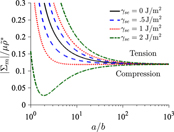Crossref Citations
This article has been cited by the following publications. This list is generated based on data provided by
Crossref.
Nitol, Mashroor S.
Adibi, Sara
Barrett, Christopher D.
and
Wilkerson, Justin W.
2020.
Solid solution softening in dislocation-starved Mg–Al alloys.
Mechanics of Materials,
Vol. 150,
Issue. ,
p.
103588.
He, Lijie
Hadi, Muhammad
Liu, Haomin
and
Abdolrahim, Niaz
2020.
Mechanism of coarsening and deformation behavior of nanoporous Cu with varying relative density.
Journal of Materials Research,
Vol. 35,
Issue. 19,
p.
2620.
Nguyen, Thao
Luscher, D.J.
and
Wilkerson, J.W.
2020.
A physics-based model and simple scaling law to predict the pressure dependence of single crystal spall strength.
Journal of the Mechanics and Physics of Solids,
Vol. 137,
Issue. ,
p.
103875.
Williams, C. L.
Mallick, D. D.
and
Wilkerson, J. W.
2020.
A Concise Note on Deformation Twinning and Spall Failure in Magnesium at the Extremes.
Journal of Dynamic Behavior of Materials,
Vol. 6,
Issue. 4,
p.
432.
Adibi, Sara
and
Wilkerson, Justin W.
2020.
Evolving structure–property relationships in metals with nonequilibrium concentrations of vacancies.
Journal of Applied Physics,
Vol. 127,
Issue. 13,
Qian, Lanting
Elmahdy, Reem
Raj Thiruppathi, Antony
and
Chen, Aicheng
2021.
An ultrasensitive electrochemical sensor for the detection of acetaminophenviaa three-dimensional hierarchical nanoporous gold wire electrode.
The Analyst,
Vol. 146,
Issue. 14,
p.
4525.
Li, Zhonghong
and
Pei, Qiang
2021.
Nano-materials on the strength of ultra-high performance concrete.
Ferroelectrics,
Vol. 578,
Issue. 1,
p.
194.
Tang, X.C.
Yao, X.H.
and
Wilkerson, Justin W.
2021.
A micromechanics-based framework to predict transitions between dimple and cup-cone fracture modes in shocked metallic glasses.
International Journal of Plasticity,
Vol. 137,
Issue. ,
p.
102884.
Zhu, Wenjie
Du, Jiguang
and
Jiang, Gang
2021.
Effect of pore shape and porosity on the elastic and fracture properties of nanoporous Mg and Mg17Al12.
Computational Materials Science,
Vol. 197,
Issue. ,
p.
110666.
Chen, Zhuochen
Zhang, Xiaoqing
Li, Wanghui
and
Yao, Xiaohu
2022.
Shock compression of nanoporous silicon carbide at high strain rate.
International Journal of Mechanical Sciences,
Vol. 224,
Issue. ,
p.
107320.
Vazquez von Bibow, N.
Millán, E.N.
and
Ruestes, C.J.
2024.
Topological changes and deformation mechanisms of nanoporous Ta under compression.
Computational Materials Science,
Vol. 236,
Issue. ,
p.
112884.
Schmelzer, Noah J.
Lieberman, Evan J.
Chen, Nan
Dunham, Samuel D.
Anghel, Veronica
Gray, George T.
and
Bronkhorst, Curt A.
2025.
Statistical evaluation of microscale stress conditions leading to void nucleation in the weak shock regime.
International Journal of Plasticity,
Vol. 188,
Issue. ,
p.
104318.
